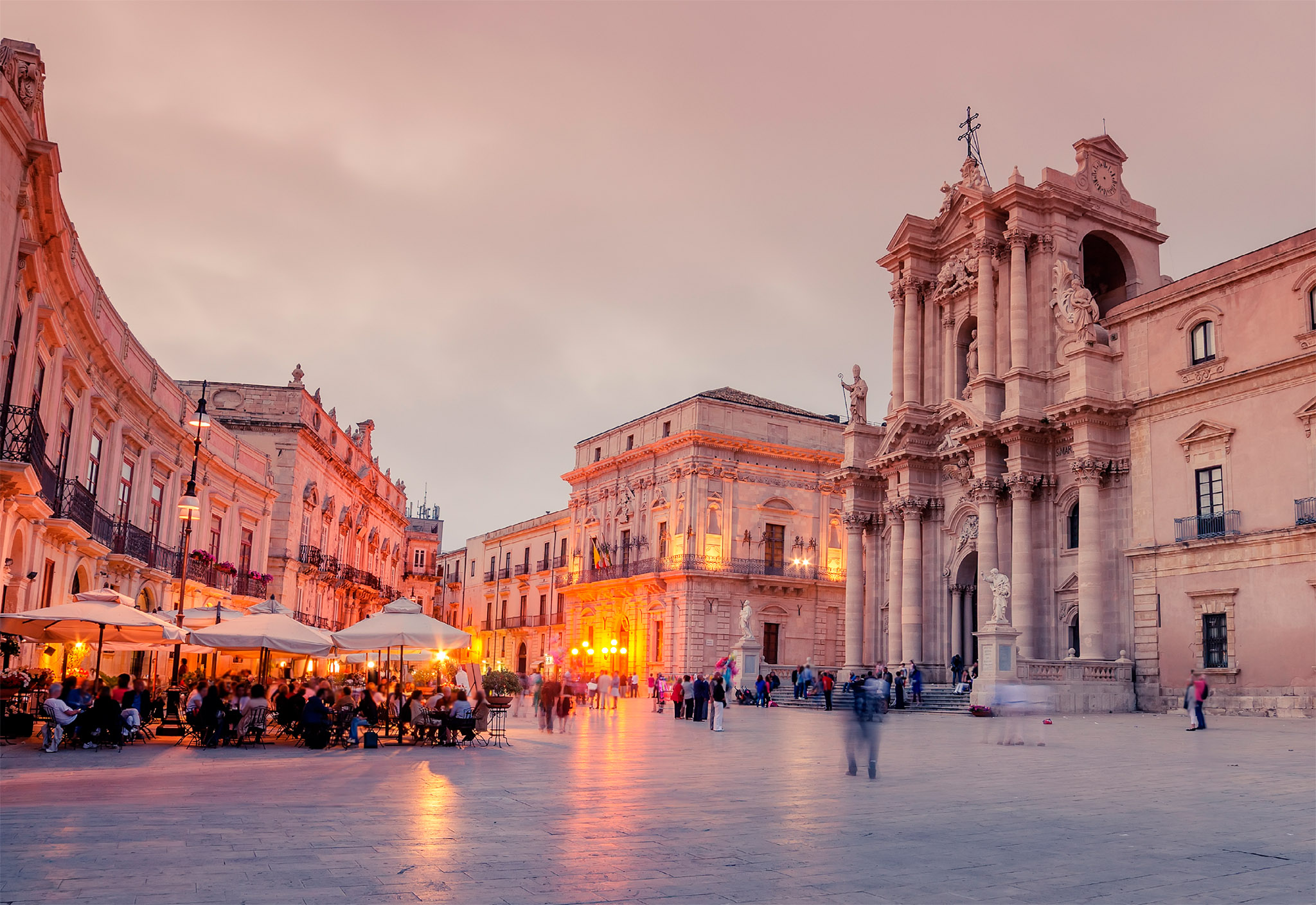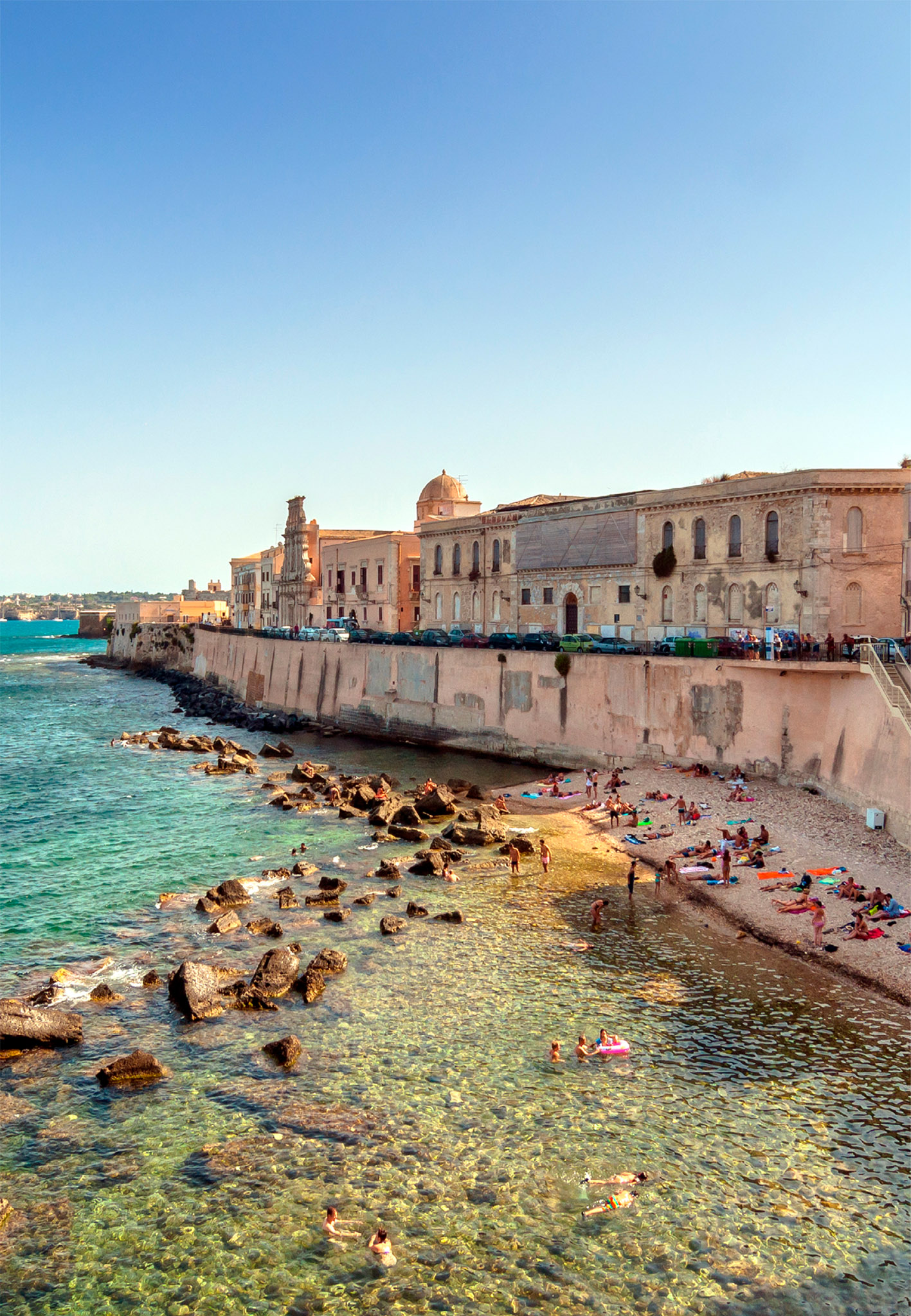
t The Piazza del Duomo and Duomo illuminated in the evening
Traces of Siracusa’s glorious past are everywhere in its historic centre, Ortigia, an offshore island where Baroque buildings of mellow golden sandstone twist and turn along a labyrinth of narrow medieval streets lined with pavement cafés, restaurants and stylish little shops. Intersperse sightseeing with lunch in the market, take a swim in one of the miniature lidos along Lungomare Levante, or enjoy a predinner drink while watching the sun set over the Porto Grande.

t The Piazza del Duomo and Duomo illuminated in the evening
Siracusa’s Duomo is an ancient Greek temple that was converted into a church sometime during the 6th century. Twelve of the Doric temple’s fluted columns are embedded in the Duomo’s battlemented Norman wall, while inside, the nave was formed by hacking eight arches in the cella walls. The Norman façade was destroyed in the earthquake of 1693 and replaced with the flamboyant Baroque edifice that now dominates the piazza.
Piazza Duomo is Sicily’s most magnificent piazza, an immense theatrical space free of traffic, except for the occasional wedding car. It is gorgeous at any time of day, but perhaps most magical at night when its pavement gleams like silk and the Baroque façades that surround it are illuminated.
The façade of Santa Lucia alla Badia, with its barley-sugar twist columns and intricate stonework, is one of Ortigia’s prettiest. The church is home of one of Siracusa’s most prized works of art, The Burial of Santa Lucia by Caravaggio. The canvas was not designed for this church but for the Church of Santa Lucia across in the Borgata, the location to the saint’s martyrdom. Bathed in shafts of sunlight, dwarfed by stark, bare plaster walls, two gravediggers brace themselves to lower the corpse of the saint into her tomb, watched by a bishop and a group of mourners.
The ruins of the oldest temple in Magna Graecia were discovered in 1860 inside an old Spanish barracks. Built in the early 6th century BC, the temple is huge – 58 m by 24 m (190 ft by 79 ft) – and over the centuries has served as a Byzantine church, a mosque and a military stronghold. Visiting in the 18th century, the French writer Vivant Denon reported finding one of the columns embedded in the wall of a bedroom of a house on the adjacent Via Resalibera. To make more room, the owner had hacked away part of the stone.
Experience Sicily
|
EAT Fratelli Burgio Siracusa’s best delicatessen has a simple outdoor restaurant among the bustle of the market, where guests can feast on platters of gourmet cheeses, hams and salamis sourced from all over Italy, along with their own cured olives, caponata, sun-dried tomatoes and other delectable conserves. ⌂ Piazza Cesare Battisti 4 ¢ Sun ∑ fratelliburgio.com \\\ |
Surrounded by papyrus plants and inhabited by a colony of ducks and bream, this fountain is fed by a freshwater spring that bubbles up under the sea. It is the origin of the myth of the nymph Arethusa, who escaped the advances of the river god Alpheios by turning into the spring, which disappeared beneath the Ionian sea and re-emerged here.

The most popular place to swim in Ortigia is the big rock at Forte Vigliena (commonly known as “Lo Scoglio”, or “the rock”) – during the summer the local council “extends” it by erecting a platform. There is also a small beach at Cala Rossa (the foot of Via Roma). There are two lidos in Ortigia, one on the Lungomare Levante (at the foot of Via Maestranze), the other below the Fonte Aretusa.
Palazzo Bellomo is a sprawling 13th-century building, whose austere, minimalist façade dates from a time when Sicily was part of the Holy Roman Empire. The palace now houses a regional art museum. A highlight of the collection is Antonello da Messina’s Annunciation, painted for a church in Palazzolo Acreide, with the Hyblaean mountains visible through the windows behind the angel.